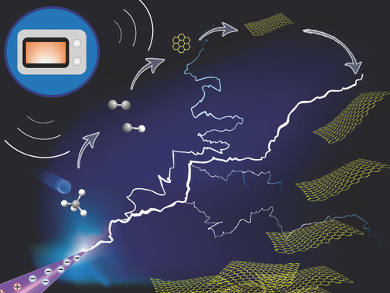Graphene is a material with very unusual and useful properties. Its preparation on a large scale, however, is still challenging. The two most commonly used approaches, chemical vapor deposition (CVD) and liquid‐phase exfoliation, either need expensive substrates and provide a limited production rate or require a complicated post-treatment and provide a limited quality.
Yingying Zhang, Beijing Graphene Institute, China, Jin Zhang, Peking University and Tsinghua University, both Beijing, China, and colleagues have developed a simple, scalable, low-cost preparation method for high-quality graphene flakes. The team placed pieces of SiO2-coated silicon into a quartz tube located in a household microwave oven. The tube was then flushed with argon to remove air, the microwave was turned on and a methane flow through the tube was used as a carbon source. The microwave radiation induces a corona discharge around the SiO2-coated silicon (an electrical discharge caused by ionization of the air around the material). This causes the methane to dissociate and graphene and molecular hydrogen are formed. The process gives high-quality graphene flakes that “snow” down onto any desired substrate (pictured).
High yields (≈ 6.28 %) and rates of graphene flake formation (≈ 0.11 g h−1) were achieved. Similar to actual snowflakes, the “snowing” graphene can self‐assemble into fluffy and foam‐like macroscopic structures. The researchers demonstrated that these can be used, for example, in high‐performance strain sensors.
- “Snowing” Graphene using Microwave Ovens,
Yangyong Sun, Liangwei Yang, Kailun Xia, Haizhou Liu, Dong Han, Yingying Zhang, Jin Zhang,
Adv. Mater. 2018.
https://doi.org/10.1002/adma.201803189




![Synthesis of [c2]Daisy Chains via Mechanochemistry](https://www.chemistryviews.org/wp-content/uploads/2025/04/202504_RotaxanesWithSolidStateMechanochemistry-125x94.png)